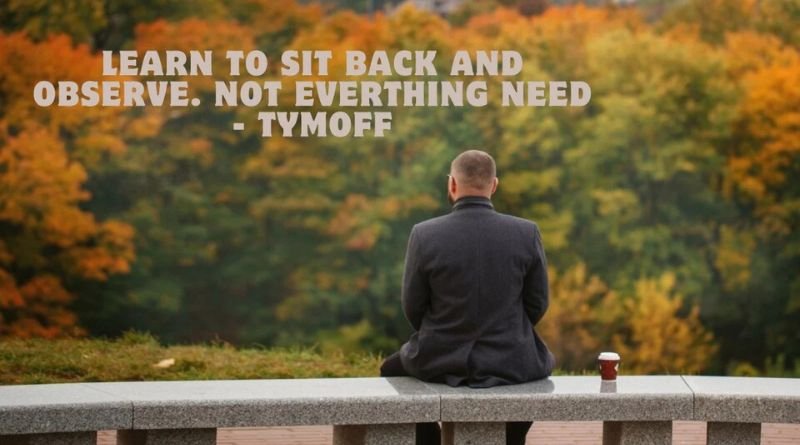In today’s fast-paced world, where reactions are often instantaneous, the idea of “sitting back and observing” might seem counterintuitive. But in reality, this simple practice can offer profound benefits to both our mental well-being and personal growth. The phrase “not everything needs a response” emphasizes the power of mindful observation, reminding us that sometimes silence and reflection can be more powerful than reacting impulsively. In this article, we will explore the benefits of learning to observe situations before responding, how it can improve decision-making, and why this practice is essential for emotional resilience.
Table of Contents
What Does It Mean to Sit Back and Observe?
To “sit back and observe” is a practice of stepping out of the immediate emotional or mental reaction to a situation. It involves taking a moment to process what is happening around you, understanding the dynamics at play, and choosing whether or not it’s worth responding to. This means resisting the urge to immediately give an opinion, offer advice, or react in the heat of the moment.
Instead of jumping into conversations or conflicts, this practice encourages being present in the moment, assessing situations from a neutral point of view, and reflecting on how best to engage (if at all). It’s about cultivating patience and learning to control emotional impulses.
Why Is It Important to Learn This Practice?
Learning to sit back and observe, rather than immediately reacting, offers many benefits that can positively impact various aspects of our lives. Some of the key reasons why this practice is valuable include:
1. Emotional Regulation
By taking a moment to pause and observe, we allow ourselves to cool off emotionally before reacting. Emotional regulation is essential for maintaining calm in challenging situations. Reacting impulsively can lead to regrets, misunderstandings, or unnecessary conflict. By observing and reflecting before responding, we give ourselves the time to decide the most constructive way to engage.
2. Improved Decision-Making
Not every situation requires a knee-jerk response. When we take the time to observe, we gain more clarity and understanding of the context, allowing us to make better, more informed decisions. Whether in personal relationships, at work, or in social situations, thoughtful consideration can lead to more effective problem-solving and stronger relationships.
3. Enhanced Self-Awareness
Sitting back and observing helps cultivate self-awareness. It allows us to examine our own thoughts and feelings in the moment, identifying why we might feel compelled to respond in certain ways. This awareness can lead to personal growth, as it offers us the chance to recognize emotional triggers and biases, enabling us to navigate situations with more balance and mindfulness.
4. Reduced Stress and Anxiety
Often, our desire to react quickly stems from anxiety about a situation or fear of being misunderstood. By choosing to observe rather than immediately react, we reduce the emotional strain and allow ourselves to process events more rationally. This reduces stress and helps us feel more in control of our emotions, leading to a more peaceful state of mind.
5. Strengthened Relationships
The art of observing and choosing when to engage can significantly improve relationships, both personally and professionally. In conversations, especially sensitive ones, taking the time to listen and process before responding shows that we value the other person’s point of view. It demonstrates patience and respect, which can lead to more meaningful and effective communication.
How to Practice Sitting Back and Observing
Here are some practical steps to incorporate this practice into your daily life:
1. Develop Mindfulness
Mindfulness is the practice of staying present in the moment without judgment. By being mindful, we become more aware of our impulses and thoughts. You can practice mindfulness through techniques such as deep breathing, meditation, or simply being conscious of your physical sensations and surroundings. Mindfulness allows you to become more attuned to when it’s time to pause and reflect.
2. Take a Moment to Breathe
When faced with a challenging situation, take a deep breath before reacting. This simple act can help you pause, regulate your emotions, and gain perspective. By allowing yourself this moment of pause, you create space for thoughtful consideration rather than emotional impulsivity.
3. Observe Without Judgment
It’s important to simply observe without rushing to make judgments about the situation or the people involved. Observe the facts, the emotions at play, and the environment around you. Try to detach yourself from the need to immediately categorize the situation as “good” or “bad.” This helps you maintain a neutral stance and make more objective choices.
4. Reflect on the Situation
After observing, take time to reflect on the situation. Consider how you feel and what the best course of action might be. Ask yourself questions like:
- Is this situation worth reacting to?
- What is my response likely to achieve?
- How can I respond constructively?
- What are the potential consequences of my response?
5. Respond When Necessary
Not every situation demands a response. If you feel that responding will add value or is necessary, then do so thoughtfully. If not, it may be best to let things unfold naturally without your intervention. Choosing to remain silent at times can be a powerful and wise response in itself.
The Benefits of Sitting Back and Observing
By learning to observe rather than react, you will experience numerous benefits:
- Clarity: You gain a clearer understanding of the situation before making any decisions.
- Emotional Balance: You prevent emotional overreaction, leading to healthier emotional responses.
- Personal Growth: You improve your ability to handle difficult situations with calm and thoughtfulness.
- Improved Communication: You become a better listener and communicator, fostering stronger relationships.
FAQs
1. Why is it important to sit back and observe?
- Sitting back and observing helps to regulate emotions, make more informed decisions, and communicate more effectively. It allows you to process situations thoughtfully rather than reacting impulsively.
2. How can I stop myself from reacting too quickly?
- Practice mindfulness techniques such as deep breathing and self-awareness. Take a brief pause before reacting, and consider the potential impact of your response. This helps create space for thoughtful action.
3. Can sitting back and observing improve my relationships?
- Yes! By choosing to listen and reflect before responding, you show respect for others’ perspectives and create an environment for better understanding, which strengthens relationships.
4. Is it possible to learn this skill?
- Absolutely. Like any skill, sitting back and observing can be developed with practice. Mindfulness and self-reflection are powerful tools to help you build this habit over time.
5. How does sitting back and observing reduce stress?
- By not immediately reacting, you reduce emotional turmoil and anxiety. This gives you the chance to evaluate situations calmly and make decisions that are in your best interest, reducing overall stress.
Conclusion
Learning to sit back and observe, rather than reacting impulsively, is a powerful practice that can transform the way we navigate the challenges of daily life. It helps us make better decisions, manage our emotions, and improve our relationships. By practicing mindfulness and developing the patience to reflect before responding, we can enhance our personal growth, communication, and emotional well-being. In a world that often prioritizes quick reactions, learning to pause and observe can be one of the most valuable skills we can cultivate for a more balanced, thoughtful life.



